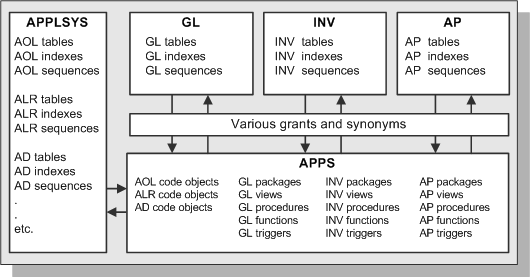A given Oracle database can store the objects associated with a single installation of Oracle E-Business Suite. In general, product code objects are stored in the APPS schema, whereas product data objects are stored in the relevant base product schemas. These schemas are described further below.
Utilizing a single schema that has access to all objects avoids cross-product dependencies, and creates a hub-and-spoke access model rather than the spider web model that would otherwise be needed. The APPS schema also improves the reliability of and reduces the time needed for installation, upgrading, and patching, by eliminating the need for cross-product grants and synonyms.
The following code objects are installed in the APPS schema:
The following objects are installed in the base product schemas:
Figure 3-1 APPS Schema and Base Product Schemas

The APPS Schema
The APPS schema has access to the complete Oracle E-Business Suite data model. It is analogous to the SYSTEM schema, which has access to the entire database. Oracle E-Business Suite responsibilities connect to an APPS schema, and the environment variable FNDNAM is set to the name of the APPS schema. The APPS schema owns all the code objects for the Oracle E-Business Suite, and has access to all data objects. There is one APPS schema for every product installation group.Utilizing a single schema that has access to all objects avoids cross-product dependencies, and creates a hub-and-spoke access model rather than the spider web model that would otherwise be needed. The APPS schema also improves the reliability of and reduces the time needed for installation, upgrading, and patching, by eliminating the need for cross-product grants and synonyms.
The following code objects are installed in the APPS schema:
- Packages
- Procedures
- Functions
- Triggers
- Views
- Materialized views
- Java classes
- Queues
Base Product Schemas
All data objects for a product are owned by a specific schema for that product, known as the base product schema.The following objects are installed in the base product schemas:
- Tables
- Sequences
- Indexes
- Constraints
- Queues
Relationship Between APPS Schema and Base Product Schemas
The base product schemas also contain grants from various tables and sequences to the APPS schema, as well as synonyms from the APPS schema to the same objects.Figure 3-1 APPS Schema and Base Product Schemas



No comments:
Post a Comment